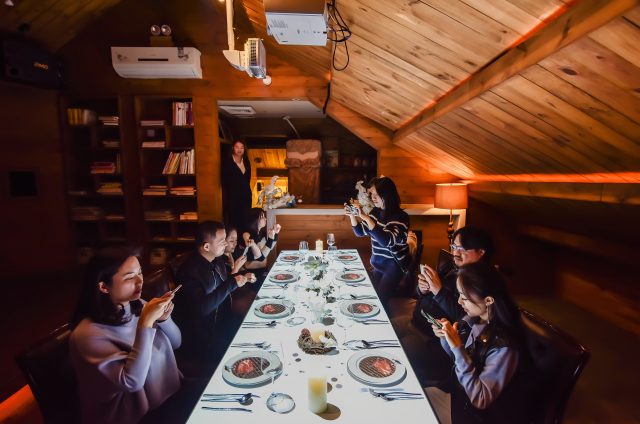Augmented reality (AR) is defined by Microsoft as an enhanced, interactive of a real-world environment achieved through digital visual elements, sounds, and other sensory stimuli via holographic technology. It has been used extensively in the entertainment industry in the form of games (e.g. Pokemon GO), music and film. Its usage has also spread to other sectors such as commerce (e.g. IKEA Place), production lines (e.g. Glass Enterprise – Google) and restaurants.
AR is an area of technology that is gaining attention among restaurant owners as a tool to enhance customer’s dining experience. There are a variety of ways in which AR can be incorporated into the food and beverage (F&B) sector. A number of restaurants have been working with different visual artists to construct scenes and animations that can be projected onto the table. One of them is Le Petit Chef.
Le Petit Chef
They are a restaurant who worked together with an artistic collective, Skullmapping, to curate an immersive culinary journey by adding theatre to dining. They bring customers through different storylines, depending on the menu that they pick upon entry, using realistic 3D animations that are projected onto the table.
Why it is engaging
They were able to captivate diners using AR technologies combined with music in the restaurant to provide a sensory immersion. It is said that the projected visuals did positively affect the customers’ dining experience, as the visuals helped in enhancing the diners’ perception of the dish that was about to be served, hence heightening their desire to taste the food that was featured.
Features
Although table mapping is not the newest AR technology, table mapping has been around for awhile, Le Petit Chef did well in a few areas.
High Definitions Projections

They installed their own projectors within the event space to streamline diners’ experience and ensure that the visuals and its effects are of the highest quality possible. This is extremely important as AR technology is fairly new and is highly dependent on the tool which is used to view them. In using the restaurants’ own HD projectors, customers will be assured that the visuals would not be pixelated or misplaced (not in the right position on the plate or table), and that their experience will not be discounted by lower quality tools (with headache-inducing visuals effects).
Curating Different Storylines
It is interesting to see that the restaurant has put in the hard work to craft different storylines for different menus that they are serving for the day. What’s most appealing to me was that they have not just decided to bring customers to different parts of the world which the dish that is served originates from, using AR. Some of the visuals also feature a miniature chef as the protagonist of the story that diners are taken on. The miniature chef on their table talks to the diners using through the speakers around the place. This does help in capturing the audience’s attention as they go down the items on the menu. By the end of the meal, customers did report that it almost felt like going to Disneyland and they felt good about the entire experience.
Areas to Improve on
Visuals for each dish
It is indeed a novel experience, however, it does get boring quite fast as there is a limited number of shows that are available for choosing. After a few repeated shows, it would start losing its lustre from the diners’ perspective. It would be unrealistic to demand that creators and owners of the restaurant put out new shows every so often due to the vast amount of time and effort it takes to craft an entirely new menu and create a new story based on it. Hence, I would suggest that the restaurant can keep this elaborate and expensive set up for those who want the whole experience (perhaps for a special occasion), but they can also use the same technology for each dish. By each dish, I mean that visuals and stories are designed for a dish, so when customers look at the menu, a 3D visual of the dish can be projected onto the table, and after they have ordered the projection will continue to tell a story about the dish until it is ready to be served. In this case, customers will be able to experience different stories each time they visit as they select different dishes for their meal.
More interactions
Currently, the augmentation that is done on the table tells a story, which makes the entire experience from a diner’s perspective equivalent to watching a film while having a meal, except that the film is closely linked with the meal. I feel that with the rise of motion detection and tracking, Le Petit Chef may be able to involve the diners in the story-telling process. Using deep learning technologies to recognise and track hand gestures, it may allow customers to not only be in awe of the 3D projections on the table, but also participate in it if they want to. I believe that this would further engage them which will in turn enhance the entire dining experience.
Conclusion
While using augmented reality technology in restaurants is still a novel concept, Le Petit Chef certainly did a great job and showed the world the possibilities in which the technology holds.
Resources
- Batat, W. (2021). How augmented reality (AR) is transforming the restaurant sector: Investigating the impact of “Le Petit Chef” on customers’ dining experiences. Technological Forecasting and Social Change, 172, 121013. https://doi.org/10.1016/j.techfore.2021.121013
- Han, D.-I. D., Boerwinkel, M., Haggis-Burridge, M., & Melissen, F. (2022). Deconstructing immersion in the experience economy framework for immersive dining experiences through mixed reality. Foods, 11(23), 3780. https://doi.org/10.3390/foods11233780
- Le Petit Chef. (2015). Skullmapping. https://skullmapping.com/project/le-petit-chef/
- Le Petit Chef | Marco Polo. (2015). https://lepetitchef.asia/main/
- What is augmented reality (AR) | Microsoft Dynamics 365. (n.d.). Microsoft Corporation. Retrieved 19 January 2023, from https://dynamics.microsoft.com/en-us/mixed-reality/guides/what-is-augmented-reality-ar/
